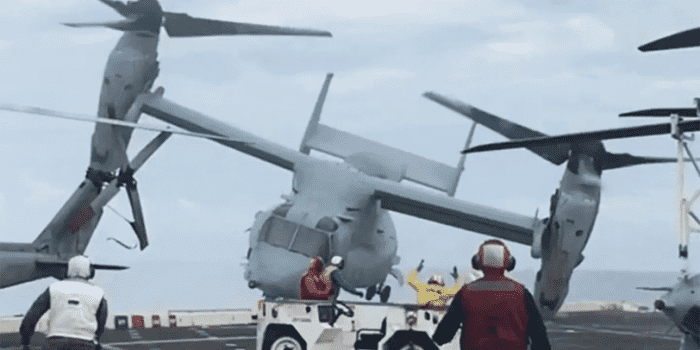A dramatic yet tragic video of an MV-22B Osprey from Marine Medium Tiltrotor Squadron 265 has surfaced. The aircraft was trying to land on USS Green Bay (LPD-20) while the ship was operating near Queensland, Australia, on August 5th, 2017. The video remained under the dust for over five years but has surfaced recently. The aircraft suddenly dropped and smacked its left engine while landing on a crowded flight deck of the San Antonio class amphibious transport dock ship. The sailor casually recording the video from around the hangar seems to run off towards the sight as soon as he realizes that the situation has turned into a nasty one.
On May 21st, 2018, USNI News published a report about the crash investigation board’s findings, stating, in part:
The investigation outlines a complex but low-risk mission. “The Marine Corps determined the aircraft crashed due to facing too much downwash and not having the thrust to hold its hover, but the aircraft may also have been carrying too much weight”. Moreover, the inquiry committee determined that none of the three individuals that succumbed to their injuries due to this incident was at fault and laid their lives while serving with good intent and professionalism.

The ill-fated Osprey was part of a hectic day of drills and rehearsals initiated by the USS Bonhomme Richard (LHD-6). It was practising a simulated embassy reinforcement and had made two round trips from the USS Bonhomme Richard (LHD-6) to Raspberry Creek to insert embassy reinforcement personnel. At the termination of the drill, the aircraft moved back to Green Bay, where the deadly incident occurred.
The Osprey also had distorted communication with the ship’s Tactical Air Navigation signal and received guidance from the ship’s air traffic controllers. Upon arrival at Green Bay, the pilots followed the laid-down procedure and were set to land at the designated spot.
The pilot, whose name is removed from the report but USNI News understands was a Marine major, “recognized and attempted to correct a 200-300 foot per minute rate of descent with an application of power using the Thrust Control Lever,” the report said, “the aircraft’s drop in altitude as it approached the flight deck. The pilot and copilot – 1st Lt. Benjamin Cross, who died in the crash – could not stop the descent and took several actions, including moving the Osprey’s nacelles forward. The left nacelle struck the Green Bay flight deck, and the Osprey moved forward along the starboard side of the flight deck until the plane hit a steel stairway. The left proprotor blades damaged the flight deck and a nearby helicopter, and the impact of the collision crushed the cockpit, breaking the hip and leg of the pilot inside. The aircraft then fell 30 feet into the water, and with a hole in the cockpit, the aircraft filled with water rapidly and sank nose-first.”
Those who died in this fatal crash were:
1st Lt. Benjamin Cross, 26, of Oxford, Maine. Cpl. Nathaniel Ordway, 21, of Sedgwick, Kansas. Pfc. Ruben Velasco, 19, of Los Angeles.
This video, we should bear in mind, serves as a stark reminder of just how fast things can go from ordinary to disastrous when it comes to rotary-wing operations. Yet, brave men and women are out there every day, all year long, undertaking these incredibly challenging tasks that are anything but risk-free.


